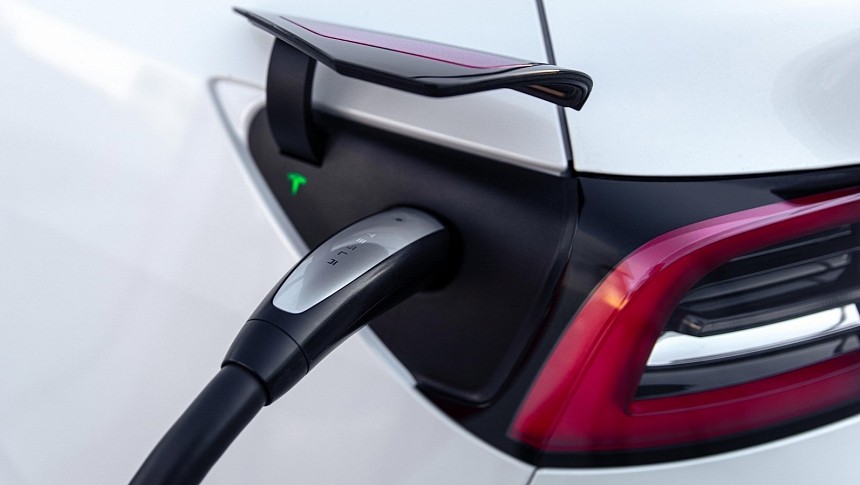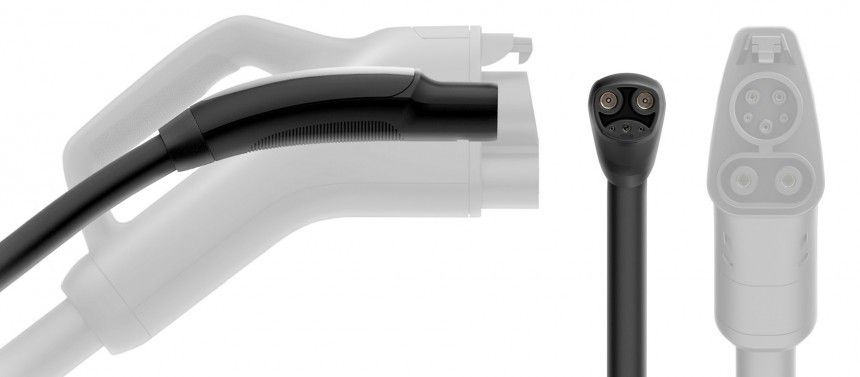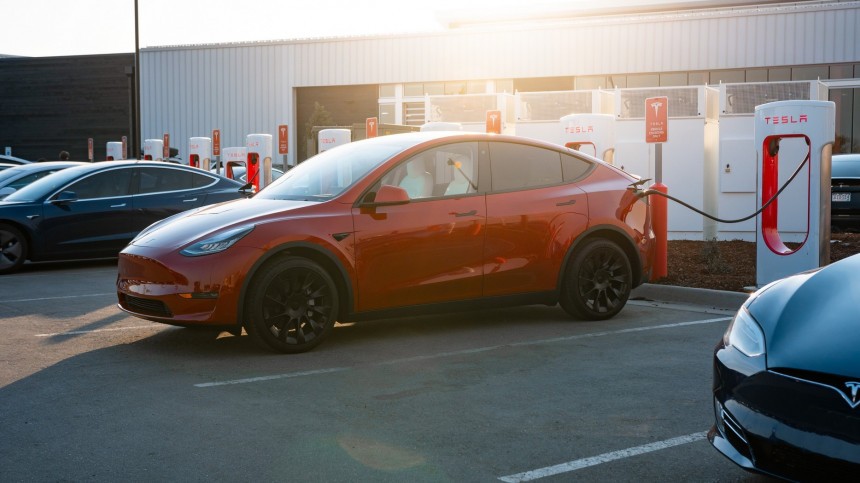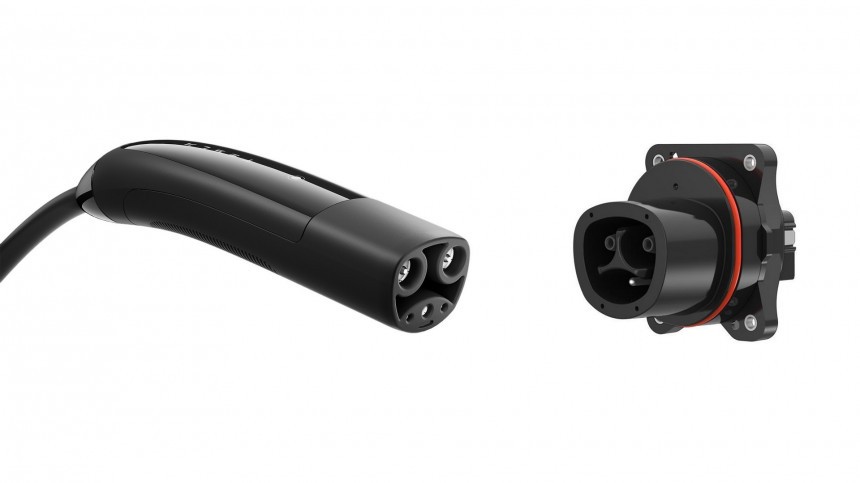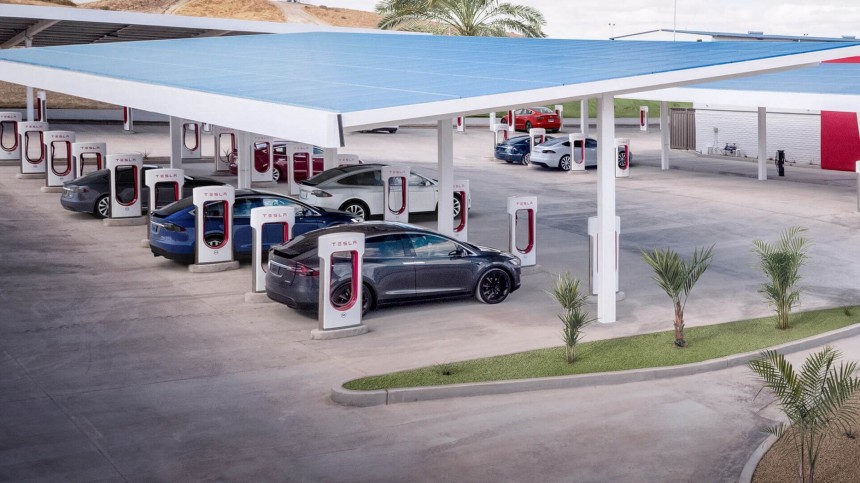When Rich Benoit said he loved his Rivian R1T and wanted the company to survive, he gave a funny reason for that: he wanted to see Rivian owners flood the crowded Supercharging stations even more than they already are. Conversely, Tesla advocates celebrate the "victory" of the North American Charging Standard (NACS) and call Ford, GM, and Rivian losers in silly memes. Well, the joke is on them: with so many more BEVs with access to Superchargers, Tesla is voluntarily joining the charging crisis that is right around the corner.
I talked about it when Rivian announced it was also adopting Tesla's charging standard: the goal was to have access to the Supercharging network. At the time, I stressed how journalists and YouTubers were trying to warn that the Tesla charging experience would not be included with NACS. In fact, the vehicles that already use Magic Docks face the same problems they complain about in other charging networks. Interrupted charging sessions and slow charging speeds are the main issues. Imagine that happening with Tesla customers waiting to charge their cars: it will be messy.
The most recent developments in this story were Volvo joining the NACS crowd – which suggests Polestar should not take long to do the same – and the Society of Automotive Engineers (SAE) committing to standardize Tesla's standard. Can we even call it a standard if SAE did not establish it as such? The BEV maker has an Autopilot that requires constant supervision and a Full Self-Driving that doesn't fully drive. Delivering a standard that is not standardized should not shock anyone.
When SAE completes its work, other automakers may feel stimulated to adopt NACS as well. Whether they cut a deal with Tesla or not, Superchargers should already be pretty crowded with the electric vehicles General Motors and Ford are planning to sell. Either Tesla is planning to double the number of Superchargers it currently has in North America by 2025, or we'll watch a fierce dispute for the ones that are available. The 2,000 stations and 12,000 stalls are already facing problems in some locations nowadays.
Calling Ford, GM, Rivian, and now Volvo losers will bite people back in a matter of two years. When these companies have NACS in their EVs, these folks trying to make it look like Tesla won something will bite their tongues while looking for a fast charge to reach their destinations. Considering how widespread the Supercharging network is, they may easily find such stations, but they will probably be busy. Ask yourself: have you heard about any expansion plans for the Supercharging network following all these automakers saying they will also use them? I haven't.
This is why it looks like Tesla is willing to take the charging crisis train that is approaching the platform. No one should forget that it was not able to address it even when it was the only company causing the waiting lines at Superchargers, especially on holidays. All it took was creating two high-volume vehicles – the Model 3 and Model Y – for things to rapidly degrade.
In April, a Tesla customer shared on Facebook groups that she was not "into this Tesla thing anymore" after her trip from Moab to Phoenix took 10 hours instead of the regular 7.5 hours this trip usually takes. Apart from the usual Tesla advocates, her post drove a lot of people to share the same impression. When she said she was tired of going out of her way and waiting too long for a charge, Superchargers were only busy with Tesla BEVs. It is easy to place these stations along interstates, but it is much more complicated to have them on other roads.
Instead of celebrating a victory only they can see, Tesla advocates and shareholders should either check its true implications or just frame it as Pyrrhic if they insist this is a win. The true scenario is Tesla diluting its major advantage to receive government incentives. For a company with the most profit in the automotive industry – perhaps of all industries, according to the numbers PwC audits and approves – and allegedly infinite demand, it is a senseless move.
In other words, Tesla could keep Superchargers exclusive if it did not want the Inflation Reduction Act (IRA) incentives. Anyone taking Tesla's charging experience for granted will be shocked by how hard it can go south with the latest news.
The same people that mock all the automakers joining NACS are the ones that will try to convince you that Tesla is opening Supercharging stations to promote electric vehicles – some from the very brands they are now trying to ridicule. If that sounds contradictory, try to figure out why they say Tesla sells autonomous cars only to bash the people who die using the beta software the company sells because they allegedly were not paying attention to the road. For the record, there are no autonomous cars for sale – and the few units that have no drivers are disrupting the traffic in San Francisco whenever they fail.
Without an urgent and accelerated increase in Supercharging stations, there are only two possible outcomes for the NACS expansion. Either Tesla owners will be as frustrated as owners of BEVs from other brands – which will harm EV adoption as a whole – or the company will eventually make Superchargers exclusive to its cars again – after the government incentives are cashed out, mind you. If there is no mechanism to prevent that, the federal government should rapidly create one.
Tesla already received CARB's ZEV credits for battery swapping without ever offering this possibility to customers. If the law does not oblige it to maintain Superchargers available to these other brands, it is not possible to say Tesla will not "regret" opening it now. The effects that this access expansion will have suggest the change will be as temporary and ill-fated as the celebration of this "victory."
The most recent developments in this story were Volvo joining the NACS crowd – which suggests Polestar should not take long to do the same – and the Society of Automotive Engineers (SAE) committing to standardize Tesla's standard. Can we even call it a standard if SAE did not establish it as such? The BEV maker has an Autopilot that requires constant supervision and a Full Self-Driving that doesn't fully drive. Delivering a standard that is not standardized should not shock anyone.
Calling Ford, GM, Rivian, and now Volvo losers will bite people back in a matter of two years. When these companies have NACS in their EVs, these folks trying to make it look like Tesla won something will bite their tongues while looking for a fast charge to reach their destinations. Considering how widespread the Supercharging network is, they may easily find such stations, but they will probably be busy. Ask yourself: have you heard about any expansion plans for the Supercharging network following all these automakers saying they will also use them? I haven't.
In April, a Tesla customer shared on Facebook groups that she was not "into this Tesla thing anymore" after her trip from Moab to Phoenix took 10 hours instead of the regular 7.5 hours this trip usually takes. Apart from the usual Tesla advocates, her post drove a lot of people to share the same impression. When she said she was tired of going out of her way and waiting too long for a charge, Superchargers were only busy with Tesla BEVs. It is easy to place these stations along interstates, but it is much more complicated to have them on other roads.
In other words, Tesla could keep Superchargers exclusive if it did not want the Inflation Reduction Act (IRA) incentives. Anyone taking Tesla's charging experience for granted will be shocked by how hard it can go south with the latest news.
The same people that mock all the automakers joining NACS are the ones that will try to convince you that Tesla is opening Supercharging stations to promote electric vehicles – some from the very brands they are now trying to ridicule. If that sounds contradictory, try to figure out why they say Tesla sells autonomous cars only to bash the people who die using the beta software the company sells because they allegedly were not paying attention to the road. For the record, there are no autonomous cars for sale – and the few units that have no drivers are disrupting the traffic in San Francisco whenever they fail.
Tesla already received CARB's ZEV credits for battery swapping without ever offering this possibility to customers. If the law does not oblige it to maintain Superchargers available to these other brands, it is not possible to say Tesla will not "regret" opening it now. The effects that this access expansion will have suggest the change will be as temporary and ill-fated as the celebration of this "victory."
